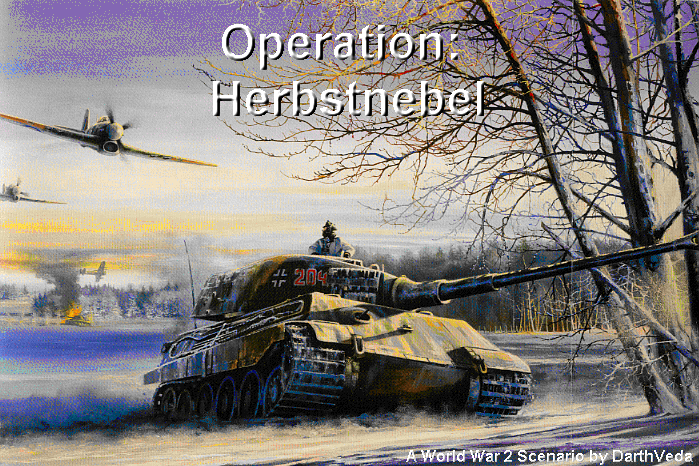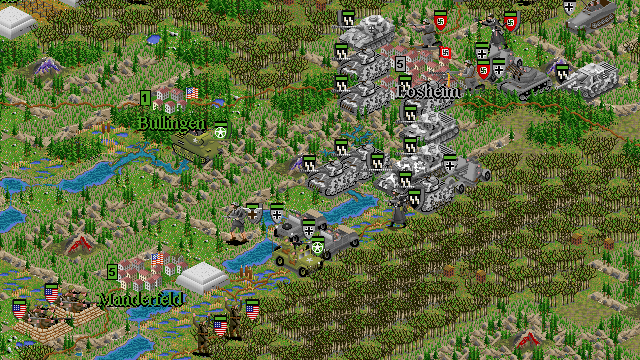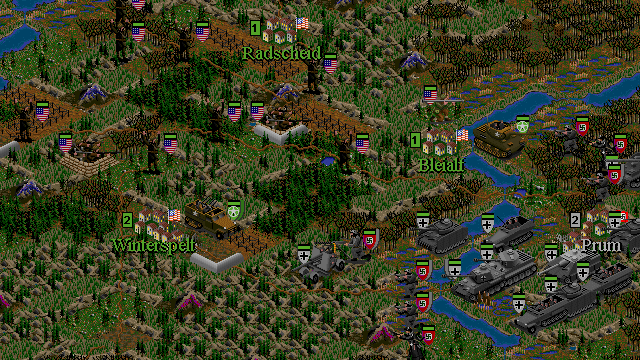Operation Herbstnebel v2.0
A scenario for Civilization II: Multiplayer Gold Edition by DarthVeda.
Description
"Soldiers of the Western Front! Your great hour has come. Large attacking armies have started against the Anglo-Americans. I do not have to tell you more than that. You feel it yourself. We gamble everything! Your carry with you the holy obligation to give all to achieve superhuman objectives for our Fatherland and our Führer!"
- - Field Marshall von Rundstedt, December 15 address
In December 1944 Adolph Hitler directed an ambitious counteroffensive with the object of regaining the initiative in the west and compelling the Allies to settle for a negotiated peace.
While the Allies bludgeoned their way into the border marches of the Reich, Hitler carefully husbanded Germany's last reserves of tanks and infantry for a desperate attempt to reverse the situation in the west. Hitler's generals were opposed to the plan, but the Fuhrer's will prevailed and the counteroffensive was launched on 16 December by some 30 German divisions against Allied lines in the Ardennes region. Allied defenses there had been thinned to provide troops for the autumn defensive. Hitler's intention was to drive through Antwerp and cut off and annihilate the British 21st Army Group and the U.S. First and Ninth Armies north of the Ardennes. German armored spearheads drove toward the Mouse River, aiming at Antwerp. Aided by bad weather, a variety of deceptive measures, and the failure of Allied intelligence correctly to interpret the signs of an impending attack, they achieved complete surprise. Elements of five U.S. divisions plus support troops fell back in confusion. Two regiments of the 106th Infantry Division, cut off and surrounded atop the mountainous Schnee Eiffel, surrendered after only brief fighting -- the largest battlefield surrender of U.S. troops in World War II.
Aided by stormy weather which grounded Allied planes and restricted observation, the Germans achieved surprise and made rapid gains at first, but firm resistance by various isolated units provided time for the U.S. First and Ninth Armies to shift against the northern flank of the penetration, for the British to send reserves to secure the line to the Meuse, and for Patton's Third Army to hit the salient from the south.
Partly as a result of the decision to continue attacking throughout the autumn, U.S. forces were spread thin in areas such as the Ardennes, and the Americans had few reserves to meet the attack. SHAEF immediately ordered available units into the threatened area, sending an airborne division into the important communications center of Bastogne. By 18 December the magnitude of the German effort was clear, and Eisenhower ordered Patton's Third Army to disengage from its offensive toward the Saar and to attack the enemy's southern flank. Scattered American units, fighting desperate rearguard actions, disrupted the German timetable, obstructing or holding key choke points -- road junctions, narrow defiles, and single-lane bridges across unfordable streams -- to buy time. Defenders at the town of St. Vith held out for six days; V Corps troops at Elsenborn Ridge repelled furious attacks, jamming the northern shoulder of the enemy advance. To the south armored and airborne troops, although completely surrounded and under heavy German attack, held Bastogne for the duration of the battle. German efforts to widen the southern shoulder of the bulge along the Sauer River came to nothing.
Denied vital roads and hampered by air attack when the weather cleared, the German attack resulted only in a large bulge in the Allied lines which did not even extend to the Meuse River, the Germans' first objective. The Americans suffered some 75,000 casualties in the Battle of the Bulge, but the Germans lost 80,000 to l00,000. German strength had been irredeemably impaired.
Short of fuel, denied critical roadnets, hammered by air attacks, and confronted by American armor, the German spearheads recoiled short of the Meuse. Meanwhile, Patton had altered the Third Army's axis of advance and attacked northward, relieving Bastogne on 26 December. On 3 January First and Ninth Army troops and British forces launched attacks against the northern shoulder of the bulge. Meanwhile, a secondary German offensive, Operation NORDWIND, failed in the south. Eisenhower had ordered the Sixth Army Group to fall back, pulling out of Strasbourg. General de Gaulle, the French leader, was enraged. After heated negotiations, Allied troops remained in Strasbourg, and the German attack lost its momentum. By the end of January the Allies had retaken all the ground lost in both German offensives. The Battle of the Bulge was over.
By the end of January 1945, American units had retaken all ground they had lost, and the defeat of Germany was clearly only a matter of time. In the east the Red Army had opened a winter offensive that was to carry, eventually, to and beyond Berlin.
Just as the Allies' August breakout had failed to achieve a war-winning decision, so, too, the German attempt to reenact its victory of June 1940 failed. The Allies, however, could make good their losses, while Hitler had squandered almost all his remaining armor and fighter aircraft. To make matters worse for the Reich, the Soviets on 12 January opened a large-scale offensive in Poland and East Prussia that carried their troops to within forty miles of Berlin. German forces that survived the Ardennes fighting had to be hurriedly shifted eastward to meet the growing Russian threat.
Screenshots
Downloads
Scenario Files (1.64 MB)
Sound Files (2.54 MB)
Scenario Guide (185 kB)


